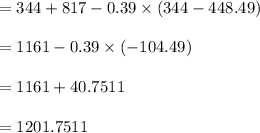Answer:
The answer is "1201.7511".
Step-by-step explanation:
Formula:

In this issue, maximum throughput capital is inventoried total assets at year-end 3 = 7% of the initial rate. It uses 7% because a computer is a MACRS class which takes three years. Because as the computer is now down 93% (33% for the first year, 45% for the second year, and 15% for the third year)


The rescue value is $344 and the stock of $817.
Financial rate = 39%
Now include these all values in the above described marginal working capital formula,
Middle of year 3 terminal value:
